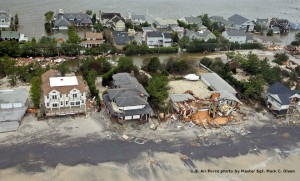New Jersey Future Blog
Proposed Sandy Plan Still Puts Taxpayer Dollars at Risk
February 12th, 2014 by Chris Sturm
Below is New Jersey Future Senior Director of State Policy Chris Sturm’s prepared testimony for the Feb. 13 public hearing on the state’s draft Sandy Recovery Action Plan Amendment, covering the next $1.46 billion in federal Sandy relief funds.
 My testimony today addresses three key aspects of the proposed New Jersey Sandy Action Plan Amendment: Does it go far enough in protecting infrastructure from future hazards? Does it give municipalities the support they need to plan for a safer future? And does it ensure the state will be transparent with its citizens about how it uses these funds?
My testimony today addresses three key aspects of the proposed New Jersey Sandy Action Plan Amendment: Does it go far enough in protecting infrastructure from future hazards? Does it give municipalities the support they need to plan for a safer future? And does it ensure the state will be transparent with its citizens about how it uses these funds?
First, on the question of infrastructure: New Jersey residents and businesses need to have infrastructure that works after future storms – so the lights come on, there is clean water to drink, roads and transit lines work, and public facilities like police, fire, hospitals and schools are functional.
The proposed plan takes some important steps: We welcome the Energy Bank to help wastewater treatment facilities keep operating when power is down, and we support the dedication of $100 million to flood hazard projects. The plan also represents an important first step by the Christie administration in acknowledging that sea level is rising and that it should be considered as New Jersey rebuilds from Sandy.
However, the plan requires consideration of sea-level rise only for $200 million worth of infrastructure projects. What about all of the other existing coastal flood risks, which are becoming more dangerous every year as sea levels rise? According to the research group Climate Central, 2,144 miles of roads face a 9 in 10 chance of being flooded by 2050, as do 46 sewage plants; 45 public schools; 44 houses of worship; 9 power plants; and 1,671 EPA-listed sites that have hazardous materials or wastewater.
Requiring broad consideration of future risks will help ensure that our infrastructure will be designed, upgraded and located to withstand future storms. To accomplish this,
- The Risk Analysis called for in the plan must be clearly defined, published for public comment and broadly applied:
- The revised plan must provide details on the required “performance resilience standards.” It should include a step-by-step process with deliverables that produces an objective set of standards usable by design and development professionals for defined categories of infrastructure.
- The revised plan must include details about which cost-benefit analysis will be used for infrastructure projects, how it will account for future maintenance costs in the face of sea-level rise, and what formulas it will use to evaluate the cost-effectiveness of green infrastructure.
- The plan must provide the actual list of projects in the $225 million pot for “non-federal cost share projects,” and the plan’s called-for risk analysis should apply to these projects. In addition, the plan should specify which projects meet the HUD threshold for a “major infrastructure project.”
- The state should use the requirement to consider sea-level rise as an opportunity to evaluate not just project enhancements but also project locations.
- State agencies must integrate the risk analysis into their capital project decision-making and require local governments to do the same. Consider the fact that there are over $17 billion worth of needed infrastructure repairs and upgrades post-Sandy that this plan does nothing to address.
Next, on the importance of good long-term planning: Planning funds will help local municipalities to prepare for future hazards, but so far, the state has proposed to dedicate less than one-half of one percent of this round of funds for this purpose.
- The proposed plan should dedicate significantly more than its current $5 million for planning grants for municipalities and counties:
- Municipalities should be required to assess the risks from sea-level rise when they receive a DCA planning grant.
- Affected towns in Cumberland County should be declared eligible for planning funds.
- Funds should be provided to allow towns to participate in FEMA’s Community Rating System program, enabling them to lower flood insurance rates.
And we have heard much recently about the lack of transparency in the use of taxpayer dollars:
- The plan should require the state to share its analysis and decisions with the public, rather than keeping them a secret. New Jersey Future has formally requested the opportunity to review the state’s draft Hazard Mitigation Plan. While the Office of Emergency Management has acknowledged our request, its representatives have not told us when the draft HMP will be ready, if we may comment on it or whether we will even be able to meet with state officials. As a second example, the state says it has analyzed 15 years’ worth of FEMA data on storm damages in order to identify areas that routinely experience loss from repeated flooding. This information should be shared with local governments and the public, and the state should work proactively with local governments to discourage new growth in these areas.
Secretary Donovan has committed to using federal taxpayer investments to help make communities across the region safer from the risks posed by sea level rise and more extreme weather events. On these three key aspects, the proposed Action Plan amendment is neither broad enough nor specific enough to honor that commitment.
















